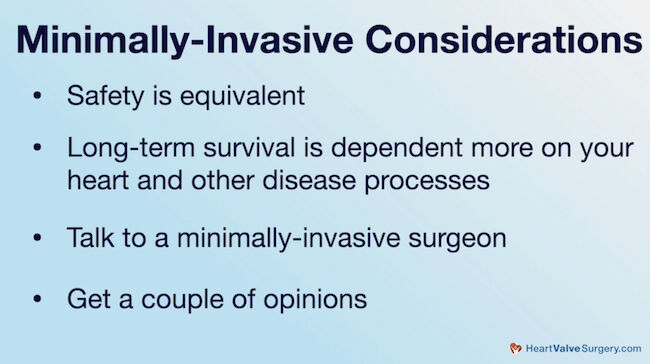Surgeon Q&A: Survival Rates of Minimally-Invasive Versus Sternotomy
Written By: Allison DeMajistre, BSN, RN, CCRN
Medical Expert: Doug Johnston, MD, Chief of Cardiac Surgery, Northwestern Medicine
Reviewed By: Adam Pick, Patient Advocate, Author & Website Founder
Published: November 4, 2024
When diagnosed with the need of undergoing heart valve surgery, patients are often curious about the benefits of minimally-invasive approaches compared to traditional sternotomy. That said, patients should realize that a minimally-invasive approach is still “open heart surgery”. While the incision is smaller during a minimally-invasive cardiac surgery, the heart will be stopped and the patient will go on the heart-lung machine.
To this point, we recently received a patient question from Sabatai on this subject. Sabatai asked, “What are the survival rates of minimally invasive versus sternotomy for heart valve therapy?” To answer this questions, we met with Dr. Doug Johnston during the Annual Meeting of The Society of Thoracic Surgeons. Dr. Johnston is the Chief of Cardiac Surgery at Northwestern Medicine in Chicago, Illinois, and has performed over 3,000 heart valve operations and has extensive experience in minimally-invasive heart valve surgeries.
Key Learnings About Minimally-Invasive Versus Sternotomy Survival Rates
Here are important insights shared by Dr. Johnston:
- Studies show that both approaches are equivalent in terms of safety. Johnston said, “Sabatai, excellent question. Patients may hear, depending on who they talk to, concerns about minimally-invasive surgery and that it is less effective or less safe. The way I would answer that is we now have many studies from large centers that do both sternotomy and small incision surgery that show us that the safety is equivalent, meaning that your chance of making it through the operation free from mortality is the same.”
- There is not much long-term data comparing survival rates for minimally-invasive to sternotomy. “We don’t have as much data about long-term survival, but what we know is if you had a good early operation and got a good valve, your long-term survival is dependent more on your heart and other disease processes,” said Dr. Johnston. “We expect that the long-term outcome will be the same.”
- Talk to surgeons who do different types of operations. Johnston told us, “It’s important to talk to somebody who does minimally-invasive surgery if you want to find out about minimally- invasive surgery. I think that a patient’s best source of information on these is to get a couple of opinions from people who do different types of operations so they can understand that this is an expert consensus to some extent. Still, there is very good data to support both.”

Patients should do their diligence when finding an experienced surgeon in minimally-invasive approaches. According to an article in Circulation, minimally-invasive techniques require a steep learning curve, and surgeons need a minimum of 75-125 successful operations with good monitoring and mentoring to reach the necessary competencies for overall safety, quality and survival outcomes.
Thanks Dr. Johnston and Northwestern Medicine!
On behalf of Sabatai and our entire patient community, thank you to Dr. Doug Johnston for sharing his experience and knowledge about minimally-invasive versus sternotomy survival rates. We also want to thank Northwestern Medicine for taking great care of our heart valve patients!
Related Links:
- Research Update: Less Invasive Aortic Valve Surgery
- Surgeon Spotlight: Dr. Doug Johnston
- Patient Prosthesis Mismatch: What Should Patients Know?
Keep on tickin,
Adam
P.S. For the deaf and hard-of-hearing members of our community, a written transcript of this interview with Dr. Johnston is provided below.
Video Transcript:
Adam: Hi everybody, it’s Adam with heartvalvesurgery.com. We’re in San Antonio at the annual meeting of The Society of Thoracic Surgeons. I am thrilled to be joined by Dr. Doug Johnston, who is the chief of cardiac surgery at Northwestern Medicine in Chicago, Illinois. Dr. Johnston, you and I have known each other for a long time. It is great to see you again.
Dr. Johnston: Great to see you, Adam.
Adam: Yeah, so we’re here at STS. We’re learning a lot and seeing some great presentations. We’re also getting patient questions coming in from around the world. This question came in from Sabatai and Sabatai asks, “What are the survival rates of minimally invasive versus sternotomy for heart valve therapy?”
Dr. Johnston: Sabatai, excellent question. This is something that comes up a lot. Patients may hear, depending on who they talk to, concerns about minimally invasive surgery that it is less effective or less safe. The way I would answer that is we now have many studies from large centers that do both sternotomy and small incision surgery that show us that the safety is equivalent, meaning that your chance of making it through the operation freedom for mortality is the same. We don’t have as much data about long-term survival, but what we know is if you had a good early operation, you get a good valve, your long-term survival is dependent more on your heart and your other disease processes, whatever else is going on with you. We expect that, that long-term outcome will be the same. It’s important to talk to somebody who does minimally invasive surgery if you want to find out about minimally invasive surgery. I think that patient’s best source of information on these are to get a couple of opinions from people who do different types of operations so they can really understand that this is to some extent an expert consensus, but there is very good data to support both.
Adam: Dr. Johnston, that is great advice. Sabatai, I hope that helped you. I know it helped me. Dr. Johnston, as always, thanks to you and your entire team at Northwestern Medicine for all the great work that you’re doing. Thanks for being with me today.
Dr. Johnston: Thanks a lot, Adam.





